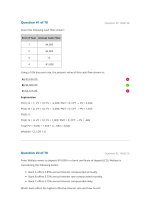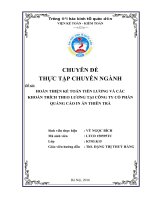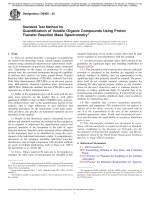Development of oral vaccine for coccidiosis protection in chicken cloning of gapdh gene from coccidia species
Bạn đang xem bản rút gọn của tài liệu. Xem và tải ngay bản đầy đủ của tài liệu tại đây (4.53 MB, 45 trang )
THAI NGUYEN UNIVERSITY
UNIVERSITY OF AGRICULTURAL AND FORESTRY
DO THI THANH TRA
TOPIC TITLE: DEVELOPMENT OF ORAL VACCINE FOR COCCIDIOSIS
PROTECTION IN CHICKEN: CLONING OF GAPDH GENE FROM
COCCIDIA SPECIES
INTERNSHIP DIARY
Study Mode
: Full-time
Major
: Biotechnology
Faculty
: Biotechnology and Food Technology
Batch
: 2014 – 2018
Thai Nguyen, 6/2018
THAI NGUYEN UNIVERSITY
UNIVERSITY OF AGRICULTURAL AND FORESTRY
DO THI THANH TRA
TOPIC TITLE: DEVELOPMENT OF ORAL VACCINE FOR
COCCIDIOSIS PROTECTION IN CHICKEN: CLONING OF GAPDH GENE
FROM COCCIDIA SPECIES
BACHELOR THESIS
Study Mode
: Full-time
Major
: Biotechnology
Faculty
: Biotechnology and Food Technology
Batch
: 2014 – 2018
Thai Nguyen, 6/2018
DOCUMENTATION PAGE WITH ABSTRACT
Thai Nguyen University of Agriculture and Forestry
Major
Biotechnology
Student name
Tra Thi Thanh Do
Student ID
DTN1453150027
Thesis title
Supervisors
Development of oral vaccine for Coccidiosis protection in
chicken: cloning of GAPDH gene from coccidia species
Asst. Prof. Dr. Kanokwan Poomputsa
Assoc. Prof. Dr. Duong Van Cuong
Abstract: Coccidiosis is one of the most important diseases in poultry and often causes
by simultaneous infections of several Eimeria species. Every chicken in a production
systemis considered to be infected with one or more Eimeria species and economic losses
are estimated to be over 1 billion dollars annually. Control of avian coccidiosis is
currently accomplished by either medication of feed with anti-coccidial drugs or
administration of live vaccines composed of low doses of Eimeria oocysts. The
increasing incidence of drug-resistance and cost of live vaccines is prompting alternative
control strategies, such as immunization of chickens with recombinant Eimeria proteins.
GAPDH is one of the immunogenic common antigens among Eimeria tenella, E.
acervulina, and E.maxima and a key glycolytic enzyme in the process of metabolism of
coccidian, as several pathogenic protozoa entirely depend on glycolysis as the source of
ATP in the host. Thus, protozoan GAPDHs are considered potential targets for antiprotozoan drugs. The genes of GAPDH cloned from E.acervulina and E.maxima were
named as EaGAPDH and EmGAPDH, respectively. Total RNA from Coccidian oocyst
were extracted by using three method to compare RNA concentration. cDNAs were
synthesized by reverse transcription reaction with primers specific to EaGAPDH and
EmGAPDH. The first strand cDNA synthesis was amplified by PCR. The PCR product
will be ligated into pGEM-TA vector.
Keywords
Coccidia – oocyst- Eimeria – GAPDH
Number of pages
35
i
ACKNOWLEDGMENTS
Firstly, I would like to express my sincere gratitude to my main advisor Asst. Prof. Dr.
Kanokwan Poomputsa for the continuous support of my internship and related research,
for her patience, motivation, and immense knowledge. Her guidance helped me in all the
time of research and writing of this thesis. I am also gratefully thank to Assoc. Prof. Dr.
Duong Van Cuong, my co-advisor who always providing useful advice for the
improvement of this work.
I thank my fellow labmates at Animal Cell Culture (ACC) laboratory, for their advises,
kind motivation, and warm friendship during my internship.
I would also like to acknowledge my teachers at TUAF, Assoc. Prof. Dr. Duong Van
Cuong, MSc. Trinh Thi Chung, Dr. Nguyen Xuan Vu that contributed to making this
work and had an enjoyable and fulfilling experience.
Last but not the least, I would like to thank my family: my parents and to my brothers and
sister for supporting me spiritually throughout writing this thesis and my life in general.
Many thank you and best regards
Student
Do Thi Thanh Tra
ii
CONTENTS
ACKNOWLEDGMENTS ....................................................................................................ii
CONTENTS ....................................................................................................................... iii
LIST OF TABLE .................................................................................................................. v
LIST OF FIGURES ............................................................................................................. vi
LIST OF ABBREVIATION...............................................................................................vii
CHAPTER 1 ......................................................................................................................... 1
INTRODUCTION ................................................................................................................ 1
1.1 Research rationale ....................................................................................................... 1
1.1.1 Chicken coccidiosis ............................................................................................. 2
1.1.2 Characteristic of chickens coccidia ..................................................................... 3
1.1.3 Life cycle of Eimeria ........................................................................................... 3
1.1.4 Coccidian oocyst wall.......................................................................................... 5
1.1.5 Glyceraldehyde 3-Phosphate dehydrogenase (GAPDH) .................................... 6
1.2 Objectives .................................................................................................................. 12
1.3 Scope of work ........................................................................................................... 12
CHAPTER 2 ....................................................................................................................... 14
MATERIALS AND METHODS ....................................................................................... 14
2.1 Instruments and materials ......................................................................................... 14
2.1.1 Types of instruments ......................................................................................... 14
2.1.2 Chemicals and materials .................................................................................... 15
2.2 Methods ..................................................................................................................... 15
2.2.1 Preparation of Coccidia oocysts ........................................................................ 15
iii
2.2.2 Preparation total RNA from Coccidian oocysts ................................................ 17
2.2.3 First strand cDNA Synthesis and PCR Amplification ...................................... 21
CHAPTER 3 ....................................................................................................................... 24
RESULTS AND DISCUSSIONS ...................................................................................... 24
3.1 Coccidian oocysts isolation ....................................................................................... 24
3.2 Breaking Coccidian oocysts ...................................................................................... 26
3.3 Total RNA isolation .................................................................................................. 27
3.4 cDNA synthesis and RT-PCR ................................................................................... 29
CHAPTER 4 ....................................................................................................................... 32
CONCLUSION .................................................................................................................. 32
4.1 Isolation Coccidian oocysts from coccivac®- D ....................................................... 32
4.2 Isolating and cloning GAPDH gene.......................................................................... 32
4.3 Recommendations ..................................................................................................... 32
REFERENCES ................................................................................................................... 33
APPENDIX ....................................................................................................................... 35
iv
LIST OF TABLE
Table 1.1 Site of development, relative pathogenicity and relative immunogenicity of the
seven species of Eimeria parasitic in chickens .................................................................... 3
Table 1.2 Scientific classification of E.acervulina............................................................... 7
Table 1.3 Scientific classification of E.maxima ................................................................... 9
Table 2.1 The instruments are used in study ...................................................................... 14
Table 2.2 Chemicals are used in study ............................................................................... 15
Table 2.3 The specific primer of E.acervulina and E.maxima ........................................... 23
Table 3.1Evaluation of quality and quantity parameters of RNA samples extracted from
Coccidian oocysts by Nanodrop ......................................................................................... 28
v
LIST OF FIGURES
Figure 1.1. Life cycle of coccidia (Eimeria spp.) ................................................................. 5
Figure 1.2 Sequence of EaGAPDH ...................................................................................... 8
Figure 1.3 Sequence of EmGAPDH. .................................................................................. 10
Figure 1.4 Amino acid similarities of GAPDH between Eimeria acervulina, E. maxima,
E. tenella, E. necatrix and E. brunetti. ............................................................................... 11
Figure 2.1 Coccivac®-D...................................................................................................... 16
Figure 2.2 Step of oocysts purification............................................................................... 16
Figure 2.3 Extraction RNA using TRIzol method ............................................................. 17
Figure 2.4 Principle of MagListoTM5M Tissue Total RNA Extraction Kit........................ 20
Figure 3.1 Steps of oocysts isolation from coccivac using density of sucrose: . ............... 24
Figure 3.2 Isolation Coccidian oocysts from Coccivac D under microscope .................... 25
Figure 3.3 Breaking Coccidian oocysts. ............................................................................. 27
Figure 3.4 RNA concentrations from different RNA isolation .......................................... 29
Figure 3.5 PCR product from cDNA synthesis using oligodT with taq polymerase on 1%
agarose gel………………………………………………………………………………30
Figure 3.6 PCR product using normal taq polymerase on 1% agarose gel ........................ 31
vi
LIST OF ABBREVIATION
ºC
Degree Celsius
µg
microgram
µL
microliter
ATP
Adenosine triphosphate
BLP
Bacteria- like- Particles
dNTP
deoxynucleoside triphosphates
E.acervulina
Eimeria acervulina
E.maxima
Eimeria maxima
E.tenella
Eimeria tenella
EaGAPDH
Eimeria acervulina Glyceraldehyde 3-Phosphate dehydrogenase
EmGAPDH
Eimeria maxima Glyceraldehyde 3-Phosphate dehydrogenase
FDA
Food and Drug Administration
GAPDH
Glyceraldehyde 3-Phosphate dehydrogenase
GEM
Gram-positive enhancer matrix
GRAS
Generally Regarded As Safe
LysM
Lysin Motif
min
minute
mL
mililiter
mm
milimeter
mM
miliMolar
ng
Nanogram
PBS
Phosphate buffered saline
pH
Potential of hydrogen
rpm
Revolutions per minute
RT-PCR
Reverse transcription polymerase chain reaction
sec
second
U
Unit
vii
CHAPTER 1
INTRODUCTION
1.1 Research rationale
Coccidiosis is one of the most important diseases in poultry and often causes by
simultaneous infections of several Eimeria species. Coccidiosis inflicts the birds in both
clinical and sub-clinical forms. The clinical form of the disease are recorded through
some remarkable signs like mortality, morbidity, diarrhea or bloody feces, and subclinical coccidiosis manifests mainly by poor weight gain and reduced efficiency of feed
conversion and gives rise to highest proportion of the total economic losses. [1]
Nowday the methods for control of coccidiosis are incorporation of anticoccidial
agent into feed or water, and use of live vaccines [2]. The first commercial live
anticoccidial vaccine, CocciVac, was introduced to the US market in 1952. It comprised a
mixture of wild-type strains of E. tenella oocysts, and conferred a homologous protection
against those strains included in the mixture. Therefore, the vaccine went through a
number of reformulations over the past 6 decades and variants of the original product,
CocciVac-B®, CocciVacD® and Immucox®, are still in use today in more than 40
countries [3, 4] In parallel live oocysts vaccines proved to be efficient in turkeys[5].
However, drawbacks of live vaccines include safety concern, short shelf-life and
difficulties of large-scale production. Since the live vaccines against coccidia are costly to
produce given further that these vaccines are strain- and species-specific, a cocktail of
antigens may be requires in order to raise protective immunity effectively. Therefore,
there is continued interest in devising new vaccines using defined recombinant antigens.
Despite that oral vaccines are safe and easy to use and convenient for all ages, all
objects. Induction of mucosal immunity is essential to stop person-to-person transmission
of pathogenic microorganisms and to limit their multiplication within the mucosal tissue.
Vaccination through a mucosal route is shown to offer advantages for enhanced mucosal
immune responses that result in better local protection [6]. Mucosal immunization with
1
subunit vaccines requires new types of antigen delivery vehicles and adjuvants
for optimal immune responses.
GAPDH is one of the immunogenic common antigens among Eimeria tenella,
E. acervulina, and E.maxima. GAPDH is a key glycolytic enzyme in the process of
metabolism of coccidian, as several pathogenic protozoa entirely depend on
glycolysis as the source of ATP in the host. Thus, protozoan GAPDHs are
considered potential targets for anti-protozoan drugs.[7]
This study was conducted by cloning of GAPDH gene from the Coccidia
species total RNA extracted using the RT-PCR technique to amplify the cDNA
sequence of the GAPDH gene Thus, the title of this study is changed to “Cloning of
GAPDH gene from Coccidia species for Coccidia oral vaccine production” which is
the first important step for development oral vaccine.
1.1.1 Chicken coccidiosis
Coccidiosis is a common protozoan disease in domestic birds and other fowl,
characterized by enteritis and bloody diarrhoea. The intestinal tract is affected, with
the exception of the renal coccidiosis in geese. Clinically, bloody faeces, ruffled
feathers, anaemia, reduced head size and somnolence are observed. Depending on
the localization of lesions in intestines, the coccidioses are divided into caecal,
induced by E. tenella, and small intestinal, induced by E. acervulina, E. brunetti, E.
maxima, E. mitis, E. mivati, E. necatrix, E. praecox and E. nagani. In caecal
coccidiosis, a marked typhlitis is present and haemorrhages are seen through the
intestinal wall. Each species has its own characteristic, site of infection,
pathogenicity and immunogenicity as shown in Table 1 [7][8].
Symptoms of coccidiosis in chickens include droopiness and listlessness, loss of
appetite, loss of yellow color in shanks, pale combs and wattles, ruffled, unthrifty
feathers, huddling or acting chilled, blood or mucus in the feces, diarrhea,
dehydration, and even death[1]. Other signs include poor feed digestion, poor
weight gain, and poor feed efficiency. Some symptoms can be confused with other
diseases. For example, necrotic enteritis is a gut disease that also causes bloody
diarrhea.
2
1.1.2 Characteristic of chickens coccidia
Coccidia are microscopic, spore-forming, single-celled protozoan parasite of the
phylum Apicomplexan and Sporozoasida class [9]. At present, species of Eimeria
may be differentiated by the dimensions and morphology of the oocysts host- and
site- specificity the morphology of the endogenous stages pathogenic effects
immunological specificity (cross-immunity) the timing of the pre-patent and patent
periods in experimental infections[9]. The species of a given genus can rarely be
differentiated by a balance of characters which may vary in significance for
particular species.
Table 1.1 Site of development, relative pathogenicity and relative immunogenicity of the
seven species of Eimeria parasitic in chickens[10]
Eimeria
species
Site of development
Pathogenicity
Immunogenicity
E. brunetti
Small intestine
Moderate to high
High
E. maxima
Jejunum, ileum
Moderate to high
High to very high
E. acervulina
Duodenum, ileum
Low to moderate
Moderate
E. necatrix
Jejunum, ileum, caeca
High to very high Low
E. tenalla
Caeca
High to very high Low
E. mitis
Ileum
Low
Moderate
E. praecox
Duodenum, jejunum
Low
Moderate
1.1.3 Life cycle of Eimeria
The life cycle of Eimeria is complex but can be conveniently viewed as occurring in
three distinct stages – sporogony, schizogony and gametogony [11][12] as shown in
Figure 1.1. Under suitable environmental conditions of oxygen supply, humidity
and temperature, the free-living stage of the organism – the oocyst – undergoes
sporogony to form a sporulated oocyst. Sporulated oocysts of Eimeria contain four
sporocysts, each of these containing two sporozoites. Following ingestion of the
sporulated oocyst by the host, the microenvironment of the host’s digestive tract
stimulates excystation of the oocyst, resulting in the release of motile sporozoites
[10]. Sporocysts and then sporozoites are released in the gut from the sporulated
3
oocyst by excystation, a process facilitated by the physical grinding effect and the
presence of digestive enzymes and bile salts. The sporozoites penetrate the gut cells
to initiate development of asexual intracellular schizonts. Schizonts divide many
times producing large numbers of a second invasive stage, called merozoites that
penetrate other gut cells to produce a further generation of schizonts [12][13]. The
number of asexual generations varies from two to four depending on the species of
Coccidia [13][14]. Asexual multiplication results in an exponential increase in
parasite numbers. Following the asexual lifecycle, a sexual lifecycle begins during
which male and female gametes form. The male and female gametes fuse to form a
zygote which develops into an immature, unsporulated oocyst that is shed onto the
litter in the feces. With each successive cycle, the number of oocysts in the
environment increases. Unless immunity has developed or an anticoccidial is used,
when the environmental conditions are favourable for sporulation of this built-up
threat, the birds will not be able to cope with this sudden, massive exposure in the
number of infective sporulated oocysts. [12] [13].
4
Figure 1.1. Life cycle of coccidia (Eimeria spp.)
www.immucox.com/Coccidiosis/Lifecycle
1.1.4 Coccidian oocyst wall
The oocyst wall is extremely robust. It is resistant to mechanical and chemical
damage; breaking oocysts for laboratory studies requires prolonged, high-speed
vortexing with glass beads and oocysts are routinely cleaned with bleach and stored
in the harsh oxidant, potassium dichromate, or the mineral acid, sulphuric
acid[14][15]. The wall is also resistant to proteolysis and impermeable to watersoluble substances, including many detergents and disinfectants[15][16].
The oocyst wall is essentially consistent in structure across different species of
coccidian parasites[16] but it is the oocyst wall of Eimeria that has been best
studied, largely because of the relative ease of acquiring large numbers of oocysts
of the parasites of this genera.
The first serious microscopic and chemical examination of the oocyst wall (of E.
maxima) was conducted by Monné and HQnig (1954), who used a number of
destructive treatments that led them to conclude that the outer layer of the oocyst
5
wall contained mainly quinone-tanned proteins without lipids, since the outer layer
reacted with ammoniacal silver nitrate solution (an indication of quinones). They
also noted that the outer layer was stripped off upon exposure to sodium
hypochlorite, whereas the structure of the inner layer remained unchanged, leading
them to conclude that the inner layer consisted of a lipid-protein matrix; they
believed that lipids were bound firmly to proteins, thus protecting the inner layer
against disintegration by sodium hypochlorite.
The first true biochemical examination of the oocyst wall was carried out by Ryley
in 1973 using E. tenella. Ryley (1973) also noted that the outer layer was removed
by sodium hypochlorite and found that it contained carbohydrates and proteins, with
high proline content, whereas the inner layer consisted of 1.5% carbohydrates, 30%
lipids and 70% proteins. The lipid in the inner layer was extractable in chloroform
and appeared to be a mixture of "waxes" containing very small amounts of nitrogen
and phosphorus. However, there are some limitations in this report: first, it did not
show detailed analyses of the experimental work and, second, it did not document
the metabolites detected in the inner wall.
1.1.5 Glyceraldehyde 3-Phosphate dehydrogenase (GAPDH)
The immunogenic common antigens among E. tenella, E. acervulina and E. maxima
is glyceraldehyde-3-phosphate dehydrogenase (GAPDH), which is a key glycolytic
enzyme that catalyzes the glyceraldehydes-3-phosphate to 1,3-diphosphoglycerate
and generates NADP+ that can enter the respiratory chain and generates an ATP in
the process of glycolysis. Owing its role in the glycolysis pathway, GAPDH was
regard merely as a housekeeping gene[17][18].
In recent years, more and more researchers found that GAPDH contains many
isomers, the function is not only involved in energy metabolism but also related
with many cellular processes of life, such as apoptosis, neuronal disorders,
viralpathogenesis, phosphotransferase activity, membrane fusion, cell endocytosis
regulating, microtubule binding, RNA output, DNA replication and DNA repair
[18, 19].
In this report, two species are used for studying is Eimeria Acervulina and Eimeria
Maxima
6
1.1.5.1 Eimeria Acervulina
a. Classification
Table 1.2 Scientific classification of E.acervulina
Domain:
Eukaryota
(unranked):
Sar
(unranked):
Alveolata
Phylum:
Apicomplexa
Class:
Conoidasida
Order:
Eucoccidiorida
Family:
Eimeriidae
Genus:
Eimeria
Species:
E. acervulina
b. Sequence of EaGAPDH
7
10
20
30
40
50
60
.... | .... | .... | .... | .... | .... | .... | .... | .... | .... | .... | .... | ....
EaGAPDH
1
ATGGTGTGCCGTATGGGAATCAACGGCTTCGGCCGCATCGGCCGTTTGGTCTTCCGCGCCGCTA
110
120
130
140
150
160
....|....|....|....|....|....|....|....|....|....|....|....|....
EaGAPDH
101
TGATGAGTGGTAACAGATAGAAACAGCACACAATGCTTTTCATTTACGCCCTTTTCCATTGAAT
210
220
230
240
250
260
.... | .... | .... | .... | .... | .... | .... | .... | .... | .... | .... | .... | ....
EaGAPDH
201
AATAGCACTACTCAGGCTACCCCCGCAGCGCTCTCTTTCGCACACACACACGCACACACACGCA
310
320
330
340
350
360
....|....|....|....|....|....|....|....|....|....|....|....|....
EaGAPDH
301
CTCAGGTGCAGAAGGTGAAAAGTCTTGTAAAATGTCCTGCGATTATGTATAAAGTGTGCAGATG
410
420
430
440
450
460
....|....|....|....|....|....|....|....|....|....|....|....|....
EaGAPDH
401
CAGTGAACGACCCGTTCATGGACGTGCAGTACATGGCCTACCAGCTGAAGTACGACTCTGTGCA
510
520
530
540
550
560
....|....|....|....|....|....|....|....|....|....|....|....|....
EaGAPDH
501
CAATTTGGTAGTGGAGGGGAAGACAATCCAAGTGTTTGCTGAGAAGGACCCCGCAGCCATTCCT
610
620
630
640
650
660
....|....|....|....|....|....|....|....|....|....|....|....|....
EaGAPDH
601
ACTGGTGTATTCACAAACAAGGAGAAGGCTGGTCTGCACATATCTGGCGGTGCTAAGAAGGTCA
710
720
730
740
750
760
.... | .... | .... | .... | .... | .... | .... | .... | .... | .... | .... | .... | ....
EaGAPDH
701
TCGTTATGGGTGTGAACCACGAGGAATACCAGCCCACTCTTCAGGTTGTTTCTAATGCTTCCTG
810
820
830
840
850
860
....|....|....|....|....|....|....|....|....|....|....|....|....
EaGAPDH
801
GCACGAGAAGTTCGGTATTGTTGAGGGTCTTATGACCACCGTGCACGCTATGACAGCTAACCAG
910
920
930
940
950
960
.... | .... | .... | .... | .... | .... | .... | .... | .... | .... | .... | .... | ....
EaGAPDH
901
TGGAGGGCTGGACGCTGTGCAGGCAGCAACATTATCCCTGCAAGCACAGGTGCAGCAAAGGCAG
1010
1020
1030
1040
1050
1060
....|....|....|....|....|....|....|....|....|....|....|....|....
EaGAPDH
1001 CAGGCATGGCTTTCCGTGTGCCCACCCCTGACGTCTCCGTCGTCGACCTCACATGCAGGCTGTC
1110
1120
1130
1140
1150
1160
....|....|....|....|....|....|....|....|....|....|....|....|....
EaGAPDH
1101 CCGTGCAGCTTCTGAGGGCCCCCTTAAGGGTATTTTGGGTGTCACAGAGGAGGAGGTTGTATCC
1210
1220
1230
1240
1250
1260
....|....|....|....|....|....|....|....|....|....|....|....|....
EaGAPDH
1201 GACGTCAAGGCAGGTATTCAGCTTAACGACTCCTTCGTTAAGCTCGTCTCCTGGTATGACAACG
1310
1320
....|....|....|....|....|....
EaGAPDH
1301 TCTACATGTCTAAGAAGGACGGCAACTAA
Figure 1.2 Sequence of EaGAPDH
8
1.1.5.2 Eimeria Maxima
a. Classification
Table 1.3 Scientific classification of E.maxima
Domain:
Eukaryota
(unranked):
SAR
(unranked):
Alveolata
Phylum:
Apicomplexa
Class:
Conoidasida
Order:
Eucoccidiorida
Family:
Eimeriidae
Genus:
Eimeria
Species:
E. maxima
b. Sequence of EmGAPDH
9
10
20
30
40
50
60
....|....|....|....|....|....|....|....|....|....|....|....|....
EmGAPDH
1
ATGGTTTGCCGCATGGGCATCAACGGCTTCGGCCGCATTGGCCGCCTGGTGTTTCGCGCTGCCA
110
120
130
140
150
160
....|....|....|....|....|....|....|....|....|....|....|....|....
EmGAPDH
101
TTTGTTGTGTATTCCCTCAGGAACAGGAAATAGGCAGTAGTATAGCCAGTAAATAACGCACCAC
210
220
230
240
250
260
....|....|....|....|....|....|....|....|....|....|....|....|....
EmGAPDH
201
GTCGTTCGGGGGAGCTGACTCTAACCGGCAACCCCCGCAGGAGCAGCAGCACCAACACTAGAAG
310
320
330
340
350
360
.... | .... | .... | .... | .... | .... | .... | .... | .... | .... | .... | .... | ....
EmGAPDH
301
CGAGAACATTCATTGGCCGTGCGTGAAGTGCATGCAATCTTCTTTGTTTGGGGCGCCTTTATCT
410
420
430
440
450
460
....|....|....|....|....|....|....|....|....|....|....|....|....
EmGAPDH
401
AGGAGGTCGTTGCAGTGAACGACCCTTTCATGGACGTGCAGTACATGGCCTACCAGCTTAAGTA
510
520
530
540
550
560
....|....|....|....|....|....|....|....|....|....|....|....|....
EmGAPDH
501
CGTTAAGGACGGAAACTTGGTTGTCAACGGCAAGACCATCAATGTGTTCGCCGAGAAGGAGCCC
610
620
630
640
650
660
.... | .... | .... | .... | .... | .... | .... | .... | .... | .... | .... | .... | ....
EmGAPDH
601
GTGTGCGAGTCCACCGGTGTCTTCACCAACAAGGAGAAGGCCGGGCTCCACATCGGTGGTGGTG
710
720
730
740
750
760
....|....|....|....|....|....|....|....|....|....|....|....|....
EmGAPDH
701
ACACCCCCATGTTCGTCATGGGTGTGAACCACGAGGAGTACCAGTCCTCTCTCCAGGTGGTCTC
810
820
830
840
850
860
....|....|....|....|....|....|....|....|....|....|....|....|....
EmGAPDH
801
TGCAAAGGTCGTTCACGAGAAGTTCGGCATTGTTGAGGGTCTCATGACAACTGTGCACGCTATG
910
920
930
940
950
960
....|....|....|....|....|....|....|....|....|....|....|....|....
EmGAPDH
901
GGTGGCAAGGACTGGAGAGCTGGACGTTGCGCAGGCAGCAACATCATCCCCGCAAGCACCGGAG
1010
1020
1030
1040
1050
1060
.... | .... | .... | .... | .... | .... | .... | .... | .... | .... | .... | .... | ....
EmGAPDH
1001 ACGGCAAGCTCACTGGTATGGCCTTCCGTGTGCCCACACCCGACGTCTCCGTCGTCGACCTTAC
1110
1120
1130
1140
1150
1160
....|....|....|....|....|....|....|....|....|....|....|....|....
EmGAPDH
1101 CGTCGCTGCCATCCGCGCTGCCTCTGAGGGTCCCCTCAAGGGCATCCTCGGCGTCACCGATGAG
1210
1220
1230
1240
1250
1260
....|....|....|....|....|....|....|....|....|....|....|....|....
EmGAPDH
1201 TCCTCCATCTTCGACGTCAAGGCCGGTATCCAGCTCAACGACACCTTCGTTAAGCTCGTCTCCT
1310
1320
1330
1340
.... | .... | .... | .... | .... | .... | .... | .... | .
EmGAPDH
1301 TTGACCTCGCCATCTACATGTCCAAGAAGGACGGCAACTGA
Figure 1.3 Sequence of EmGAPDH.
10
1
1
2
3
4
5
6
69.7
68.4
69.7
68.8
69.1
1
ChGAPDH.pro
87.7
95.0
92.6
94.1
2
EaGAPDH.pro
88.7
86.5
87.4
3
EbGAPDH.pro
91.4
92.6
4
EmGAPDH.pro
97.3
5
EnGAPDH.pro
6
EtGAPDH.pro
2
38.8
3
41.0
13.4
4
38.8
4.3
12.3
5
40.3
7.8
15.0
9.1
6
39.8
6.2
13.8
7.8
2.7
1
2
3
4
5
6
Figure 1.4 Amino acid similarities of GAPDH between Eimeria acervulina, E.
maxima, E. tenella, E. necatrix and E. brunetti. ChGAPDH=GAPDH of Chichken;
EtGAPDH=GAPDH
EbGAPDH=GAPDH
of
of
E.
tenella;
E.brunetti;
EaGAPDH=GAPDH
of
EmGAPDH=GAPDH
E.
acervulina;
of
E.maxima;
EnGAPDH=GAPDH of E. necatrix[20]
BLAST analysis revealed that EaGAPDH and EmGAPDH shared similarities of
99% in nucleotides and amino acid sequences with the genes in NCBI (Gene ID:
EaGAPDH 25337292; EmGAPDH 25268815), respectively. GAPDH shared
similarities of more than 86% in amino acid among five species of chicken coccidia.
11
1.2 Objectives
1. Isolation Coccidian oocysts from coccivac®- D
2. Isolating and cloning GAPDH gene
1.3 Scope of work
1. Isolation and purification Coccidian oocysts from coccivac
2. Breaking Coccidian oocysts wall
3. Isolation total RNA from Coccidian oocysts
4. First strand cDNA Synthesis
5. PCR Amplification of First Strand cDNA of E.acervulina and E.maxima
12
Development oral vaccine using
BLPs for Coccidosis in Chicken
Lactococcus lactis culture,
Isolation and purification
growth in MRS broth medium
Coccidian oocysts from
and harvesting cells
L.Lactis treatment to make
Binding of GAPDH- PA to
BLP
Breaking Coccidian
Isolation total RNA from
Coccidian oocysts
First strand cDNA
My work
Synthesis and
ACC lab’s work
Cloning of Eimeria
GAPDH gene
Preparation of GAPDH–
protein anchor fusions
Overexpression of
GAPDH- PA fusions
13
CHAPTER 2
MATERIALS AND METHODS
2.1 Instruments and materials
2.1.1 Types of instruments
Table 2.1 The instruments are used in study
No.
1
Name
Company
Holten MS-2010 1.2 Laminar Flow Thermo Scientific
Country
USA
Cabinet
2
Microscope D70
Olympus
US
3
Centrifuge MIKRO 200 Zenfuge
Hettich
Germany
4
Vortex genie 2
Scientific
USA
Industries Inc.
5
Accublock Digital Dry Bath
Labnet
USA
International
6
Sorvall Legend (centrifuge machine) Thermo Scientific
USA
7
Autoclave HVE-50
Hirayama
Japan
8
Water Bath WB7 bain-marie
Memmert
Germany
9
T100 Thermal Cycler
Bio-Rad
USA
10
E1101
Accuris
MyGel
Mini Benchmark
USA
Electrophoresis System
Scientific
11
UV InGenius3
SYNGENE
USA
12
Autopipette
Labnet
USA
International
13
Microscopic slide HAD
Yancheng Huida
China
medical
instruments co.,
Ltd
14
Glassbeads 0.5mm
BioSpec
US
15
Nanodrop 1000
Thermo Scientific
USA
14
2.1.2 Chemicals and materials
Table 2.2 Chemicals are used in study
No.
Name
Company
Country
Schering-Plough
USA
1
Coccivac®-D
2
Sucrose (C12H22O11)
Ajax Finechem Pty Ltd.
New Zealand
3
Glycerol
Ajax Finechem Pty Ltd.
New Zealand
Ajax Finechem Pty Ltd.
New Zealand
MERCK
Germany
Signma Aldrich
Germany
Carlo Erba Reagent
Italy
4
5
Disodium hydrogen phosphate
(Na2HPO4)
Phenol
Disodium hydrogen phosphate
6
dodecahydrate
(Na2HPO4.12H2O)
7
Sodium Chloride(NaCl)
8
Chloroform
Thermo Scientific
USA
9
Ethanol
Thermo Scientific
USA
10 TRIzol
Invitrogen
USA
11 Agarose
Thermo Scientific
USA
Signma Aldrich
Germany
LiChrosolv®
Germany
Qiagen
Germany
Bioneer
Korea
12 Trichloroacetic acid(C2HCl3O2)
13 Isopropanol
14 Rneasy Protect Mini Kit 50
15
MagListo™ 5M Tissue Total
RNA Extraction Kit
2.2 Methods
2.2.1 Preparation of Coccidia oocysts
Coccivac®-D, a commercial coccidiosis vaccine from Schering-Plough company
(USA), was used as unsporulated oocysts resource. This vaccine contains live
oocysts of E.acervulina, E.mivati, E.maxima, E. tenella, E.necatrix, E.praecox,
E.brunetti and E.hagani. Purified Coccidia oocysts by Gradient and Floatation
technique using Modified Sheather solution (500 grams of sucrose, 5 mL of Phenol
and 350 mL of distilled water)[21]. This simple technique is used for separating
15
oocysts from large quantities of fecal material. By allowing the heavier particles to
sediment from a suspension of fecal material, the lighter oocysts could be collected
along with the supernatant. Unsporulated oocysts were mixed with MSS and vortex
then carefully overlay the sucrose suspension with distilled water. Next, centrifuge
5,000 rpm for 5 min at room temperature. Carefully collect the top water and
transfer to new tube. Repeat this step several times. Add full tube with distilled
water then centrifuge 14,000 rpm for 20 min. Throw supernatant then wash pellet
with PBS several times. Finally, resuspend pellet in distilled water. Impurity check
was performed under microscope. The extracted coccidia was kept at -20ºC until
used.
Figure 2.1 Coccivac®-D
Firgure 2.2 Step of oocysts purification[21].
16









